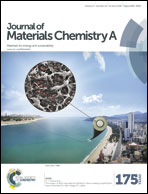Influence of a π-bridge dependent molecular configuration on the optical and electrical characteristics of organic solar cells†
Abstract
A new solution processed A–π–D–π–A type small molecule denoted as DCATT-L has been synthesized as a donor for bulk-heterojunction (BHJ) solar cells. Compared with its isomer DCATT, reported in our previous work, DCATT-L possesses the same building blocks, but different π-bridge configurations and hence different backbone configurations. Changing the π-bridge with delicate designs, the absorption coefficient is increased significantly and the highest occupied molecular orbital (HOMO) energy level is decreased by 0.1 eV. The excellent optical and electrical properties of DCATT-L guarantee the enhancement of power conversion efficiency (PCE) to 7.72%, compared with that of DCATT (5.20%), with simultaneously increasing open-circuit voltage, short-circuit current density and fill factor.


 Please wait while we load your content...
Please wait while we load your content...